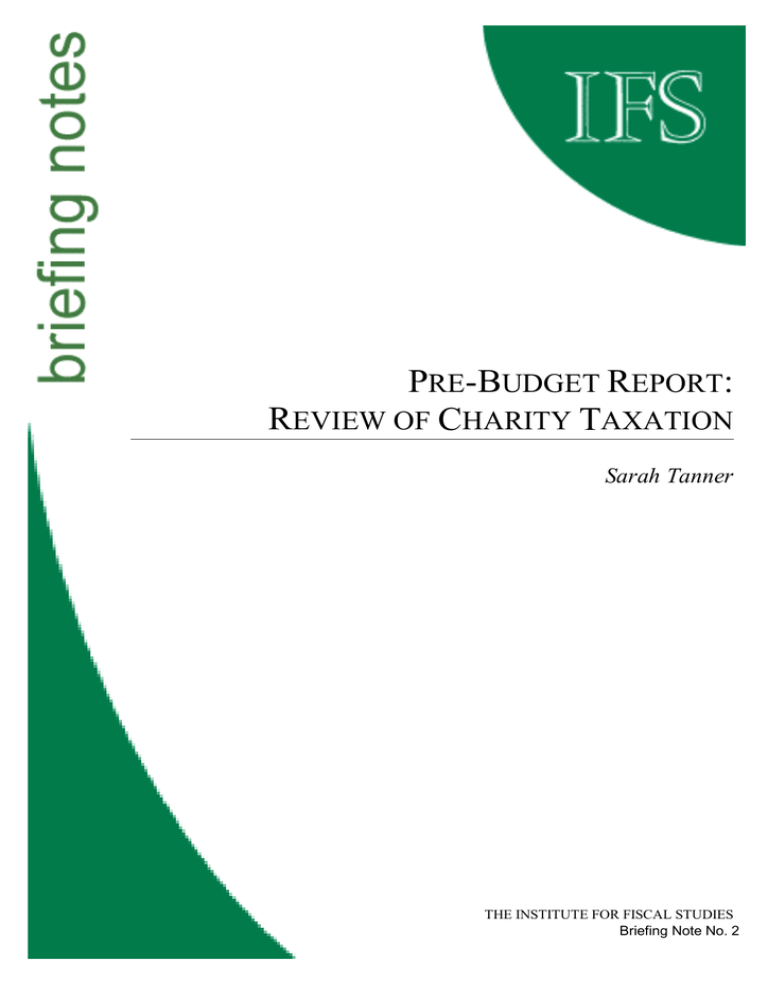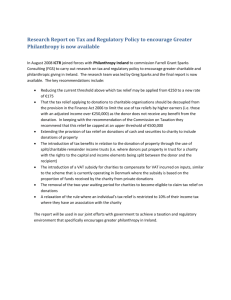P -B R :
advertisement

PRE-BUDGET REPORT: REVIEW OF CHARITY TAXATION Sarah Tanner THE INSTITUTE FOR FISCAL STUDIES Briefing Note No. 2 Published by The Institute for Fiscal Studies 7 Ridgmount Street London WC1E 7AE Tel 020 7291 4800 Fax 020 7323 4780 mailbox@ifs.org.uk www.ifs.org.uk © Institute for Fiscal Studies, October 1999 ISBN 1-903274-03-6 Published online at http://www.ifs.org.uk Pre-Budget Report: Review of charity taxation The following changes were announced in the Pre-Budget to the taxation of charitable donations: • The Gift Aid threshold (currently £250) will be reduced to zero. In effect all donations made through the Gift Aid scheme, whatever size and whether one-off or regular will be tax-free. These proposals go further than those in the government’s earlier consultation document1 which proposed a reduction in the Gift Aid threshold to £100. • The current £1,200 ceiling on annual donations through payroll giving scheme will be abolished. • There will also be a short-term boost to the payroll giving scheme. Donations made through payroll giving schemes will receive a 10% government supplement payable for three years. There will also be a government-funded promotional campaign. • There will be new income tax relief for gifts of quoted shares and securities. Evaluation Research, including work done by IFS,2 has shown that the number of people giving to charity has been declining over the past twenty years – and in particular the number of young people giving to charity. In the light of this trend, the government is extending tax relief on charitable donations as a way of encouraging giving. There are already a number of ways that people can give to charity tax-free. These are covenants, Gift Aid (and Millennium Gift Aid) and payroll giving schemes. Having a number of different schemes may increase the level of confusion about how to give tax-free. Also, the existing schemes limit tax-free giving to people who were prepared to commit to giving to charity over a reasonably long period through a covenant or people who were able to make a large donation through Gift Aid or people whose employer had set up a payroll giving scheme. The current set of proposals goes some way towards simplifying the system since most people will be able to make all tax-free donations through the Gift Aid schemes. Also removing the Gift Aid threshold is welcome since it extends tax-free giving to the mass of givers who give only small and irregular 1 2 Review of Charity Taxation, HM Treasury, March 1999 The State of Donation, IFS Commentary No. 62 amounts. People will still have to join the Gift Aid scheme to take advantage of tax relief, suggesting that collecting tin donations may miss out (“charities will still need to be able to show an audit trail from a donation to the donor”). However, individuals will be able to join the scheme by phone or over the internet. The onus is on charities to ensure that all donors join the scheme. The plans to kick-start give-as-you-earn schemes come as a result of the very low levels of participation in such schemes – less than 2 per cent of all individuals on PAYE – and low levels of awareness. However, the proposal to give additional support to payroll giving schemes is contrary to the trend towards greater simplicity and equality. Payroll giving schemes obviously exclude all people who are not on PAYE, including the self-employed and most pensioners. The reason for favouring this particular type of giving – by a particular group of people – needs to be made more explicit, since it is far from obvious. A more difficult question to answer at this stage is what effect the increase in tax relief will have on individual donations to charity. Giving tax-relief is not a free lunch for charities. The opportunity cost may be most clearly seen as the government giving up tax revenue which it could pass on to charities as grants. But tax relief may be a more effective way of using government revenue to support charities if there is a knock-on effect of tax relief increasing individual donations. The possible danger is that tax relief may cause givers to reduce the size of their donations knowing that the government is providing a top up.3 How much will these proposals cost? There is no official costing of these proposals. An estimated £5-6 billion is given to charities by individuals.4 Of this £1 billion is legacy income and £1.75 billion is currently given tax-free through covenants (£1.25 billion), Gift Aid (£500 million) and payroll giving schemes (£29 million).5 That leaves an estimated £3 – 4 billion currently given out of taxed income. Assuming no change in giving behaviour, extending basic rate tax relief to this level of giving would cost the government between £0.84 – £1.12 billion. The cost of existing tax reliefs on individual donations is less than £0.5 billion. 3 For a discussion of these issues see Taxing Charitable Giving, IFS Commentary No. 75 Dimensions of the Voluntary Sector 1998, CAF 5 Figures from Inland Revenue Statistics 1999 4 Existing tax-free giving schemes Covenants As long as the covenant runs for at least 3 years, covenanters can get relief from income tax on their donations. The charity claims back basic rate tax on the gift; higher rate taxpayers can claim the difference between the basic rate and the higher rate from their Inland Revenue tax office. There is no upper limit on the size of covenanted gifts. Gift Aid Established in 1990, the Gift Aid scheme offered tax relief on one-off donations of money above a minimum threshold. Originally, the threshold was set at £600 (after deduction of basic rate tax), but this was reduced to £400 from May 1992 and to £250 from March 1993. An original upper limit of £5 million was also abolished in March 1991. The operation of Gift Aid is very similar to that of a covenant. Donations are made net of basic rate tax; the charity recovers the basic rate tax and higher rate tax payers may claim additional tax relief on the grossed up amount from their own tax office. An extension — the Millennium Gift Aid scheme — was announced in December 1997 and introduced in July 1998 to run until 31 December 2000. The scheme reduces the lower limit to £100 on donations to charities supporting education, health and anti-poverty projects in 80 nominated ‘poor countries’. The scheme also allows smaller donations to be bundled up and still qualify for tax relief. Give As You Earn Payroll giving schemes, or Give As You Earn (GAYE) were established in 1987. Under such a scheme, employees can authorise their employer to deduct amounts from their pay and nominate the charities to which their gifts should go. This requires the employers to contract with an Inland Revenue approved collection agency. The donation is deducted from pay before calculating tax due under Pay-As-You-Earn. The key difference between tax deductions and conventional tax credits is the possibility (as with pension deductions, for example) that giving to charity can move taxpayers to a lower marginal tax rate. Since individual’s taxable income is calculated net of all donations the deduction itself could move an individual from the higher to the basic rate. This is also true for covenanted payments. On its introduction, gifts made under payroll giving schemes could not exceed £120 a year. Since then, the upper limit has been raised from time to time and currently stands at £1,200. By 1996-97 370,000 employees were participating (reflecting 5,200 contracted employers).




